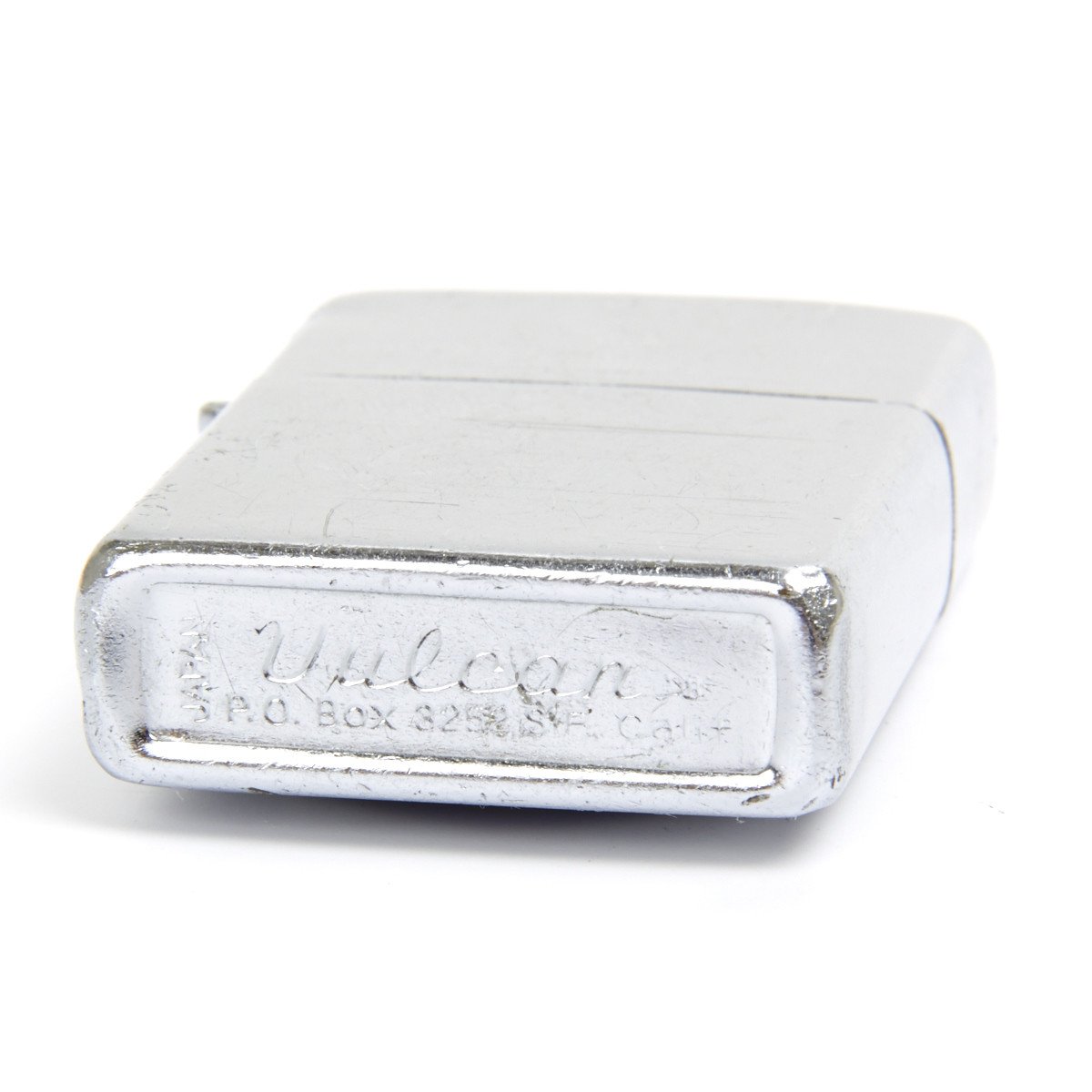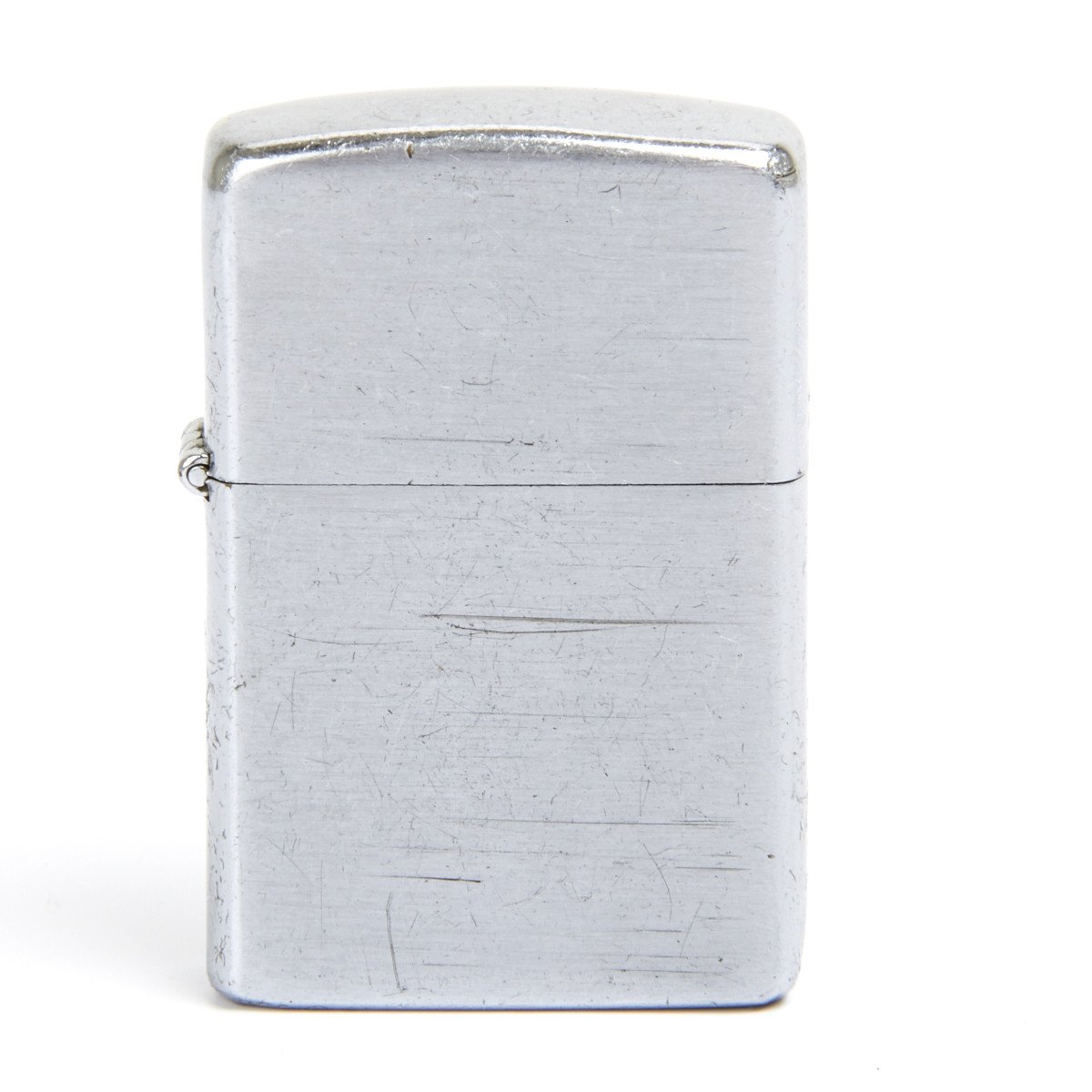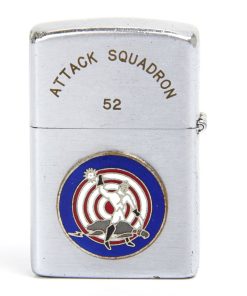Original 1966 Vietnam War Era Zippo Style Lighter Naval Aviator Attack Squadron 52 KNIGHTRIDERS- By Vulcan Original Items
$ 125,00 $ 50,00
Original Item: Lighters could be customized with regimental cyphers and engravings, and were purchased by GIs returning home as a memento of their military service in the specific theatre of operation.
Excellent vintage ZIPPO style windproof lighter circa 1966 made by VULCAN of Japan.
The design depicts an armored Knight with a fearsome mace riding a large sea turtle. This unique weapon system is superimposed over a target. The Knight portrays the crew of our aircraft; he is the legendary protector of freedom and honor and exemplifies todays Naval Aviator. The Knight is holding a mace, an ancient and foreboding weapon. In medieval times, the mace was as feared in the hands of a skillful Knight as our modern air-to-ground weapons are today. The mace is an excellent symbol of our powerful striking ability. The Knight with his weapon is riding a large sea turtle. The turtle is the fabled denizen of the sea whose determination, stamina, and navigational abilities are legend. His heavily armored shell and close association with the sea, as well as his always being on the surface of the land or in the sea, aptly symbolize our Navy attack aircraft with their reliability and low level capability. The turtles inclusion in the patch is not meant to indicate lack of speed. Unlike his brother the land tortoise, the sea-turtle is a capable and speedy performer when in his element, the sea. The entire weapon system, mace, Knight, and turtle are superimposed over a target. They have arrived at their objective and destruction of the target is inevitable.
Command History
Attack Squadron FIVE TWO (VA-52) has had a long and distinguished history as an integral part of Naval Aviation. The squadron’s roots can be traced back to shortly after World War II with the commissioning of Reserve Fighter Squadron 884 flying the F4U-4 Corsair. The “”Bitter Birds”” of VF-884 were called to active duty as a result of the Korean conflict, and they conducted their first combat operations in March 1951.
During the command’s second combat deployment to Korea, the “Bitter Birds” were redesigned as the active duty squadron VF-144. In February 1953, VF-144 completed its second combat tour, and shortly thereafter transitioned to the F9F-5 Cougar. The “”Bitter Birds”” made two peacetime deployments to the Mediterranean and Western Pacific and transitioned to the F9F-8B Cougar in April 1956. VF-144 made one more WestPac cruise on the USS HORNET (CV-12), and their final deployment bringing the USS RANGER (CV-61) from the Atlantic to the Pacific Fleet in August 1958.
On February 23, 1959 VF-144’s mission was changed to Attack and the “Bitter Birds” were redesigned as the VA-52 Knightriders. Now flying the A-1J Skyraider (designated at the time as the “”AD-7″”), the Knightriders made four deployments to the Pacific aboard USS TICONDEROGA (CV-14) and USS LEXINGTON (CV-16) prior to making their first combat cruise to Vietnam in 1964. The Knightriders provided air support during the torpedo boat attacks on the USS MADDOX (DD-731), and were involved in the initial retaliatory strikes against North Vietnam following that incident.
VA-52 made two more deployments with the Skyraider to Vietnam before entering the jet age with the advanced A-6A Intruder on 10 November 1967. The Knightriders also made a squadron move to NAS Whidbey Island that same year. The Intruder’s side by side seating enhanced its ability to fulfill its primary mission: A true medium-attack, all-weather capability. The Intruder utilized its advanced radar to navigate through mountain valleys at low levels in order to minimize the aircraft’s risk from enemy radar-guided missiles. The Intruder could carry a large payload over long distances and deliver its weapons more accurately than ever possible before. On September 7, 1968 VA-51 made its first Vietnam combat deployment with the Intruder aboard the USS CORAL SEA (CVA-43) with Carrier Air Wing 15. The Knightriders again saw combat in Vietnam during their next two cruises with Carrier Air Wing 11 aboard USS KITTY HAWK (CVA-63). On their second Kitty Hawk cruise the Knightriders flew the improved A-6B and were introduced to the KA-6D tanker.
Fast Shipping with Professional Packaging
Thanks to our longstanding association with UPS FedEx DHL, and other major international carriers, we are able to provide a range of shipping options. Our warehouse staff is expertly trained and will wrap your products according to our exact and precise specifications. Prior to shipping, your goods will be thoroughly examined and securely secured. We ship to thousands clients each day across multiple countries. This shows how we're dedicated to be the largest retailer on the internet. Warehouses and distribution centres can be located throughout Europe as well as the USA.
Note: Orders with more than one item will be assigned a processing date depending on the item.
Before shipping before shipping, we'll conduct a thorough inspection of the items you have ordered. Today, the majority of orders will be delivered within 48 hours. The delivery time will be between 3-7 days.
Returns
The stock is dynamic and we cannot completely manage it because multiple stakeholders are involved, including our factory and warehouse. So the actual stock may alter at any time. It's possible that you may not receive your order once the order has been made.
Our policy is valid for a period of 30 days. If you don't receive the product within 30 days, we are not able to issue a refund or an exchange.
You can only return an item if it is unused and in the same state as the day you received it. You must have the item in its original packaging.
Related products
Uncategorized
Uncategorized
Australian WWII Owen MK1 Machine Carbine SMG Custom Fabricated Replica with Sling Original Items
Uncategorized
Angolan Rebel 1970s era 60mm Inert Display Mortar from Angolan Civil War Original Items
Uncategorized
Uncategorized
Uncategorized
Uncategorized
Uncategorized
Uncategorized
Uncategorized
Uncategorized
Armored Burgonet Helmet & Polearm from Scottish Castle Leith Hall Circa 1700 Original Items
Uncategorized
Uncategorized
Uncategorized
Uncategorized
Uncategorized











































































